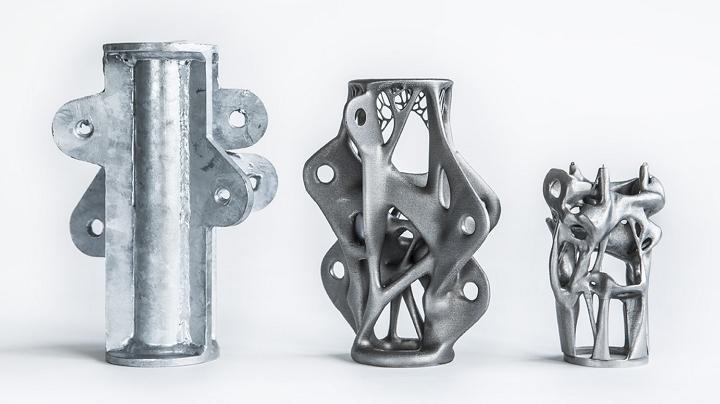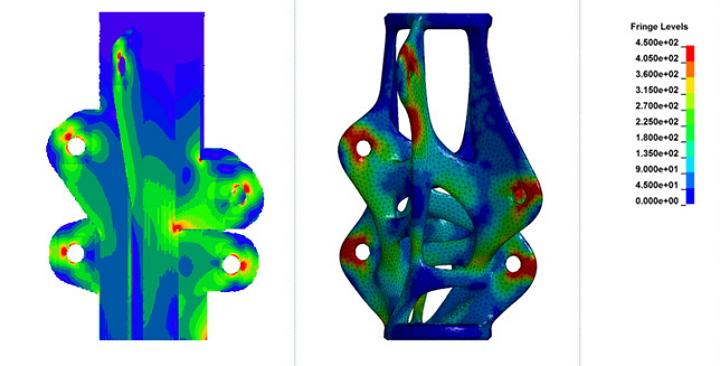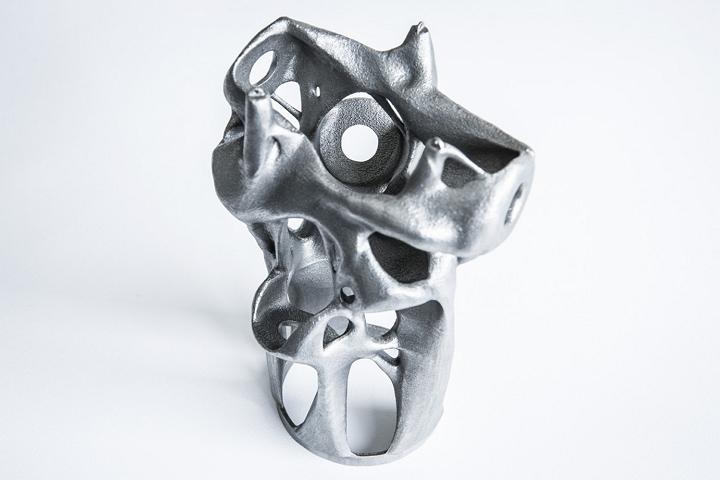Back in1946, the philosopher and engineer Ove Arup opened a consulting engineering practice in London, and Arup became well-known for his firm’s collaborations with the leading and avant-garde architects of the day. In 1976, Arup cemented his reputation with the completion of the Sydney Opera House project. Noted for a wide breadth of expertise in offshore engineering, acoustics, façade construction, and skills in blast, risk, and seismic engineering, he and his company even designed transport containers for nuclear waste.

Traditionally welded and fabricated part on the left as compared to the additively manufactured versions on the right. All three pieces have the same structural strength.
Arup engineers are continuing that legacy by pushing the boundaries of 3D printing for construction.
One of their most recent innovations, using the latest additive manufacturing techniques to design critical structural steel components for complex architectural projects, signals a new wave in the use of 3D design in construction and engineering. The company’s research has identified opportunities to reduce costs, waste, and the carbon footprint associated with construction processes.
And it’s not the first time Arup has used their experience to create challenging structures. The company cites the “tensegrity” work they did on the Kurilpa Bridge in Australia, with its wildly complex geometry, as an example of the nodes they’ve built that showcase the possibilities of AM.
“By using additive manufacturing we can create lots of complex individually designed pieces far more efficiently,” says Salomé Galjaard, a team leader for Arup. “This has tremendous implications for reducing costs and cutting waste. But most importantly, this approach potentially enables a very sophisticated design, without the need to simplify the design in a later stage to lower costs.”
Arup recently funded development work on a collaborative project with a number of partners to realize their latest component designs. Working alongside WithinLab – an engineering design software and consulting company – CRDM 3D Systems, and EOS, the company found it was possible to create structural objects which feature a significant weight reduction over previous designs.
These structural elements are designed and built with the very latest optimization and manufacturing methods.
“In the case of this particular piece, the height is approximately half that of one designed for traditional production methods, while the direct weight reduction per node is 75%,” Galjaard says. “On a construction project, that means we could be looking at an overall weight reduction of the total structure of more than 40%. But the really exciting part is that this technique can potentially be applied to any industry that uses complex, high quality, metal products.”
Galjaard says the potential impact of the techniques has tremendous implications, and it allows Arup and their team to build far smaller, lighter elements  which can deliver the same function and strength as those created by traditional methods.
which can deliver the same function and strength as those created by traditional methods.
“We have been working on this for some time now and we’re really excited about how fast we’re progressing,” said Galjaard. “We’re really pushing the boundaries here.”
If you’d like to read a groundbreaking work on the subject of ‘tensegrity’ and geometric design elements, you can check out a fascinating piece on the subject by cosmologist, architect, and engineer R. Buckminster Fuller.
What do you think of the work of Arup and Salomé Galjaard to push the boundaries of architecture and construction? Let us know in the Cutting Edge of 3D Printing forum thread on 3DPB.com. Check out some of the 3D printed pieces, below, designed by Arup engineers.
Subscribe to Our Email Newsletter
Stay up-to-date on all the latest news from the 3D printing industry and receive information and offers from third party vendors.
You May Also Like
Precision at the Microscale: UK Researchers Advance Medical Devices with BMF’s 3D Printing Tech
University of Nottingham researchers are using Boston Micro Fabrication‘s (BMF) 3D printing technology to develop medical devices that improve compatibility with human tissue. Funded by a UK grant, this project...
3D Printing Webinar and Event Roundup: April 21, 2024
It’s another busy week of webinars and events, starting with Hannover Messe in Germany and continuing with Metalcasting Congress, Chinaplas, TechBlick’s Innovation Festival, and more. Stratasys continues its advanced training...
3D Printing Webinar and Event Roundup: March 17, 2024
It’s another busy week of webinars and events, including SALMED 2024 and AM Forum in Berlin. Stratasys continues its in-person training and is offering two webinars, ASTM is holding a...
3D Printed Micro Antenna is 15% Smaller and 6X Lighter
Horizon Microtechnologies has achieved success in creating a high-frequency D-Band horn antenna through micro 3D printing. However, this achievement did not rely solely on 3D printing; it involved a combination...

































